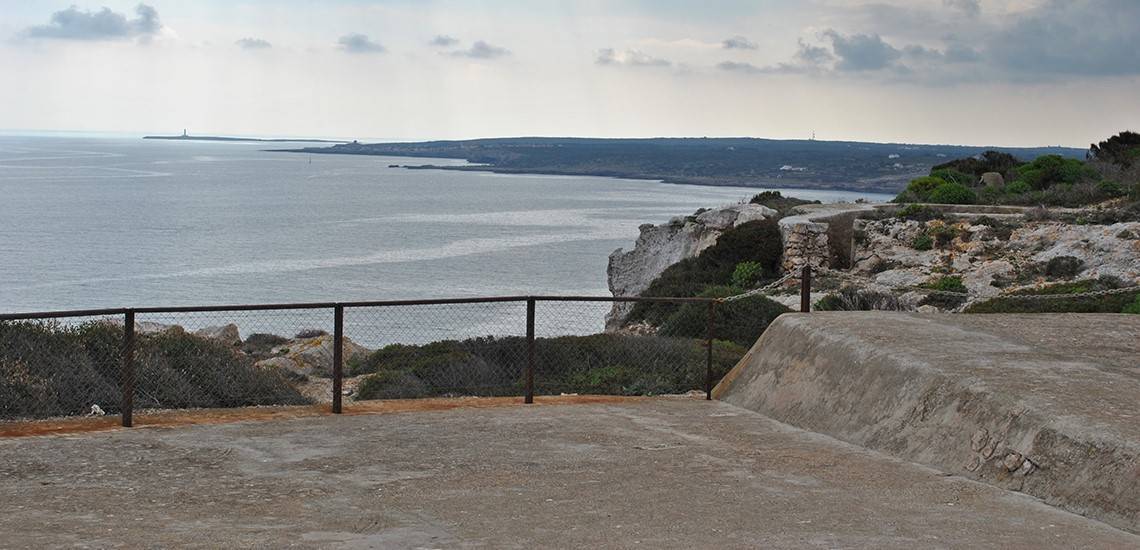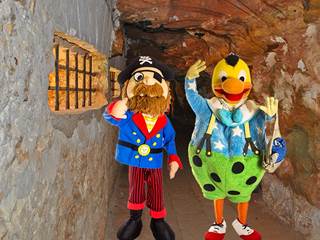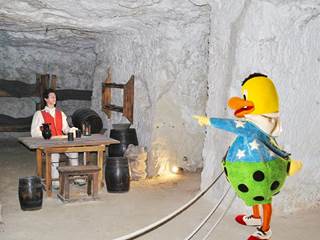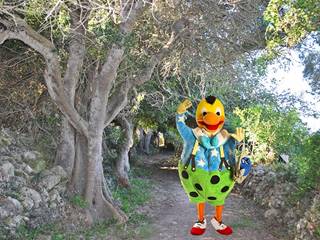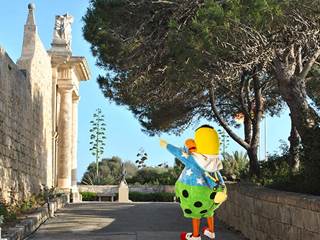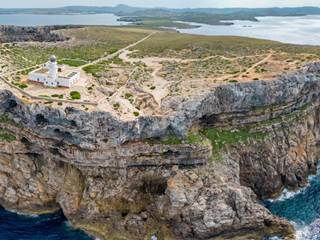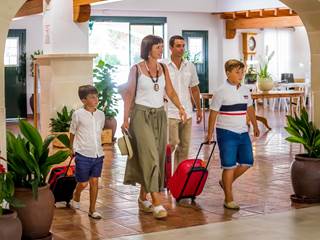Excursiones
Have you heard about the adventures of Kiko in the Fortress of La Mola in Menorca?
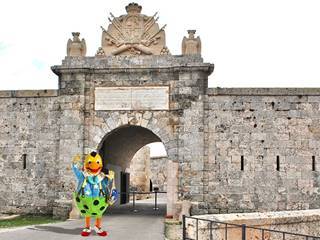
Today we are going to visit the Fortress of Isabel II. It is the largest construction that has been built in Menorca. It was built to defend the island from attacks from out sea and it is located right at the entrance of the port of Mahon, the largest natural harbor in the Mediterranean.
The story about this fortress is called La Mola and starts of at the front door. There you will see a large stone crowned arch with two shields on the sides. It is the front door of the Queen Isabell II of Bourbon, a young Spanish queen who visited this place more than 150 years ago, when the constructions was still not finished at that time.
British or Spanish?
The first thing we see when we enter is a square with large arcades on the sides and in the middle a carriage that use to be used to carry guns. It is the oldest one left in Spain.
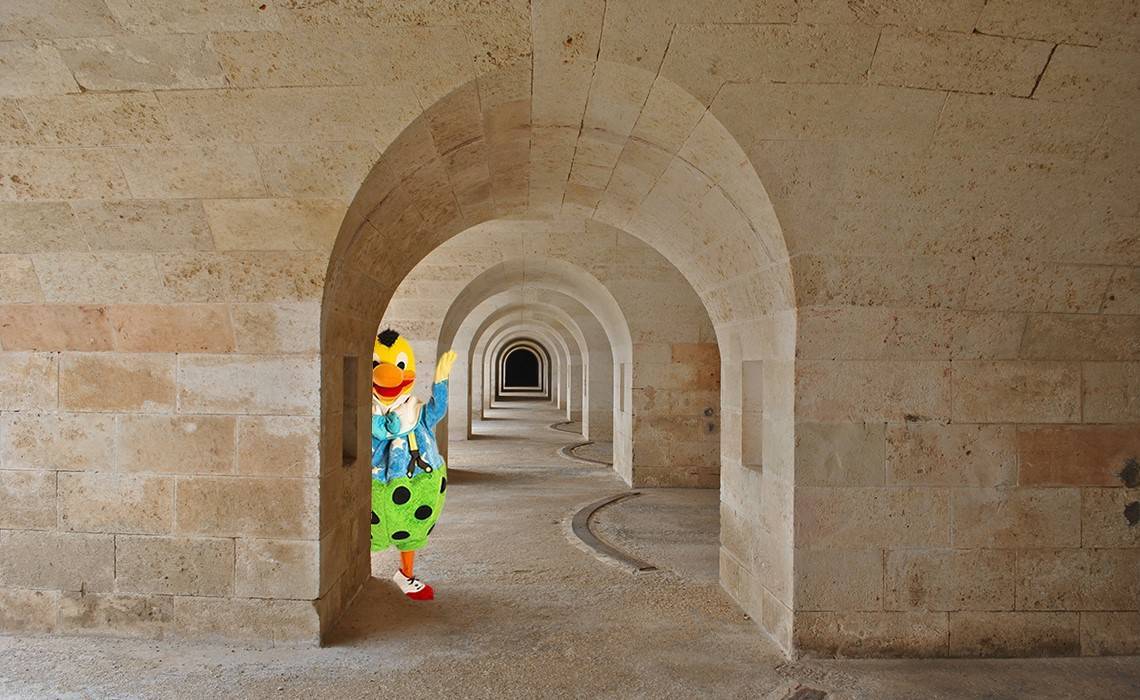 This whole area was built by the Spanish military but the idea of using this part of La Mola as a place of surveillance and defense was thought by the British military. They started building a fort, Santa Ana, more than 300 years ago, although they never finished it.
This whole area was built by the Spanish military but the idea of using this part of La Mola as a place of surveillance and defense was thought by the British military. They started building a fort, Santa Ana, more than 300 years ago, although they never finished it.
Rooms in the rocks
We go down a short path that takes us to the soldiers' old rooms. On one side there is a viewpoint from which you can see El Clot, a sea entrance where some sailors took the opportunity to anchor their boats and swim in the sea.
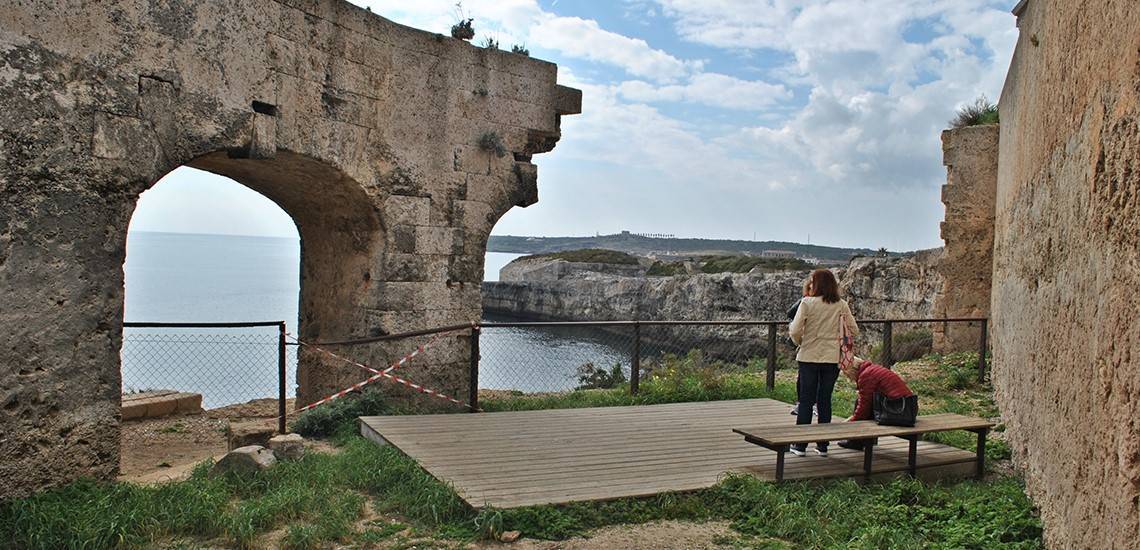 We were followed by a group of young people when going down towards the underground galleries. It´s a little scary! It is all illuminated but, in the shadows, you can see the interior of the department stores where they kept food and weapons.
We were followed by a group of young people when going down towards the underground galleries. It´s a little scary! It is all illuminated but, in the shadows, you can see the interior of the department stores where they kept food and weapons.
Do you know what chamomile is?
We went out into the daylight again. The walk is very beautiful. In the distance we can see Mahón and Es Castell and, closer, the island of Lazareto. Today, it's a little cloudy, but the fields look really good. Chamomile plants will soon begin to bloom.
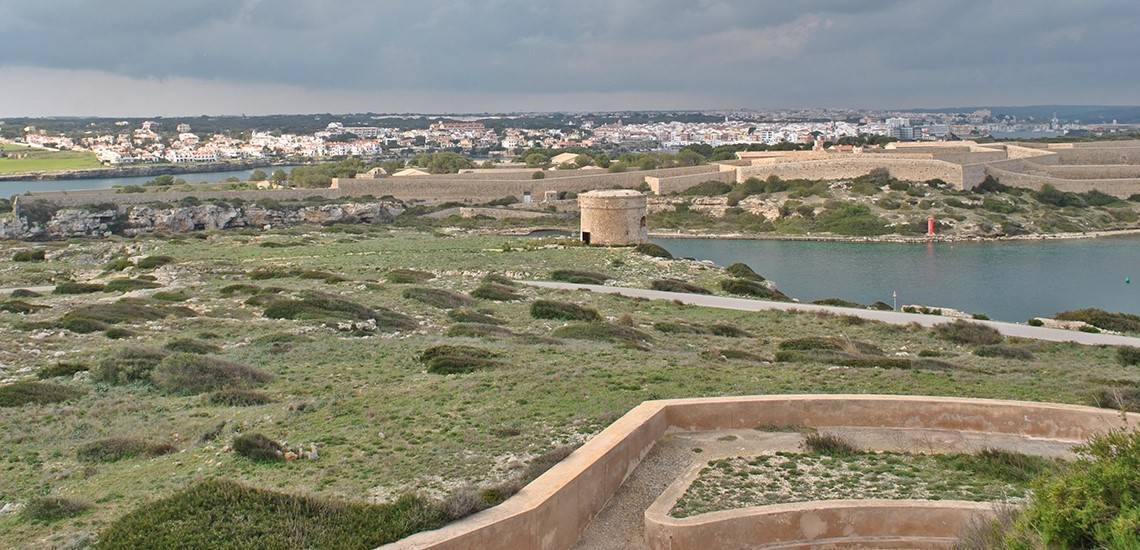 Have you ever taken an infusion with camomile from Menorca? It is a shrub with small yellow flowers that, when the summer begins, are collected and allowed to dry. Pour a few flowers in hot boiling water and taste the exquisite flavor and its many medicinal affects it has.
Have you ever taken an infusion with camomile from Menorca? It is a shrub with small yellow flowers that, when the summer begins, are collected and allowed to dry. Pour a few flowers in hot boiling water and taste the exquisite flavor and its many medicinal affects it has.
The threats that drove La Mola
We have already spoken about of the importance of the port of Maó as a place for shelter for the sailors who crossed the Mediterranean, and that is why the French and British disputed.
In 1802 the British ceded Menorca to the Spaniards but it seemed they were not very satisfied. They thought that they would not defend the island as they should and were afraid that another country would therefore be able to conquer it. So the British decide to give them a warning: if the Spaniards could not take care of Menorca, they would invade again.
The 54 guns of the Hornabeque
Therefore, in 1850 they began with the construction of this fortress, and one of the most important places is the Hornabeque, a stone fortification with large galleries and a viewpoint from which you can see some breathtaking views. I am sure no boat dared to approach here!
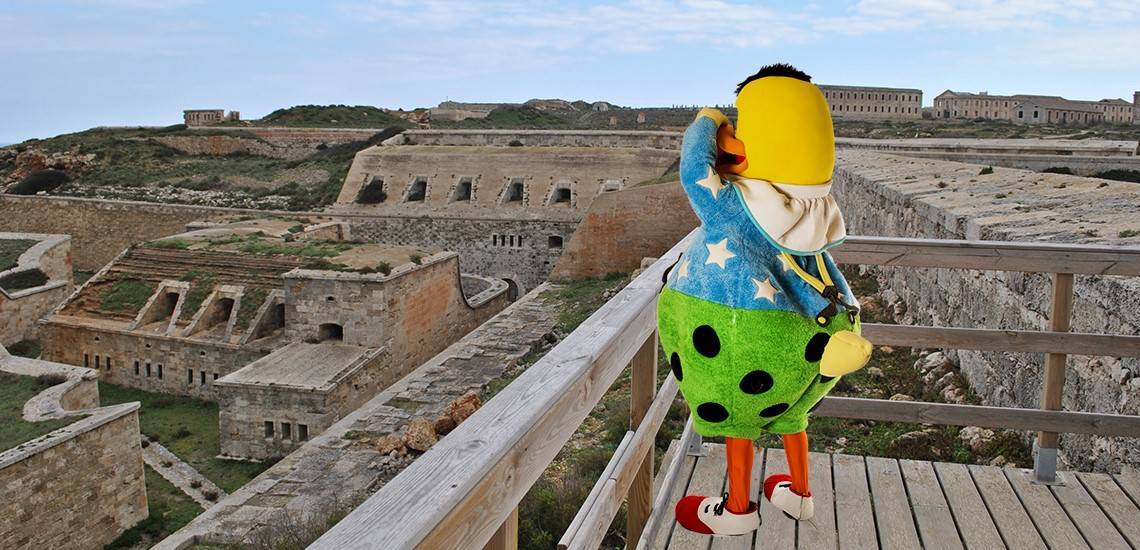 At the entrance there are a few checkpoints were the soldiers stood guard. I get into one of them and pretend to play a soldier that is guarding the entrance of the Hornabeque:
At the entrance there are a few checkpoints were the soldiers stood guard. I get into one of them and pretend to play a soldier that is guarding the entrance of the Hornabeque:
"Oh, what a fright!" A lady says when walking by.
She laughs and I walk along with her to see an old carriage that is exposed in the entrance. She is very nice, her name is Maria, and she invites me for a drink in the bar in the great esplanade of this fort.
Do you hear the White Lady?
Maria and her friends ask me if I have heard about the legend of La Mola, the one of the White Lady:
"Do you not know her?" They ask me mysterious.
I do not know anything about a legend, could you tell me?
They approach me and explain that the wife of a Spanish officer, Countess Rocamari, was shot here.
Yes, they threw her of the cliff and thought she did not survived but she lived and they could hear her moan. They listened to her for days, until she died, Maria tells me with a sad face.
One of her friends said that "on rain stormy nights you can still hear the groans of the Countess walking on the cliffs"
I must have looked terrified because everyone was laughing. The moans that are heard are from the wind between the rocks and the sounds of the birds that nest there! I almost believed it and hoped to see the White Lady walking among the rocks!
Shall we go to the gallery?
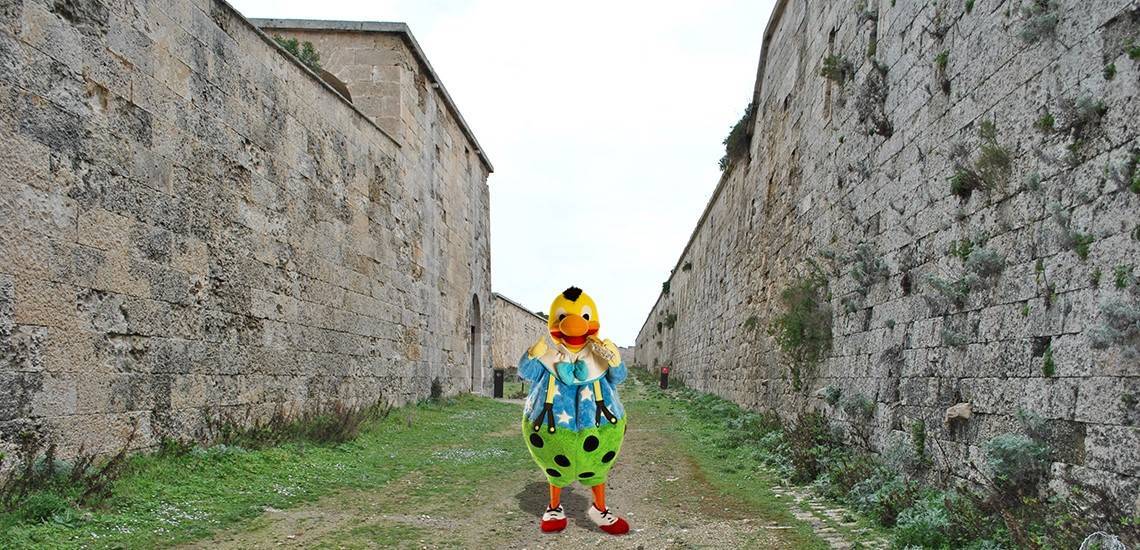 Shall we go to the gallery?
Shall we go to the gallery?
We continue the route and we arrive at a great moat that surrounds part of the La Mola where there is an underground gallery composed of 48 small enclosures where the soldiers were placed with their rifles to defend the fortress. They are joined by arches: 48 arcs followed along almost 400 meters. It is a gallery and it is amazing.
We run through the arches and pretend to be soldiers firing through the narrow openings through which only one rifle fits.
We passed through the ruins of the Princess Tower which was built by the English more than 200 years ago and rest for a while in another viewpoint from which you can see the buildings in the moat.
Have you seen a canyon bigger than this?
We pass the prison of La Mola, the Penitentiary, which is in a very bad condition and we see a construction in the color red: it is the Polvorín de la Reina.
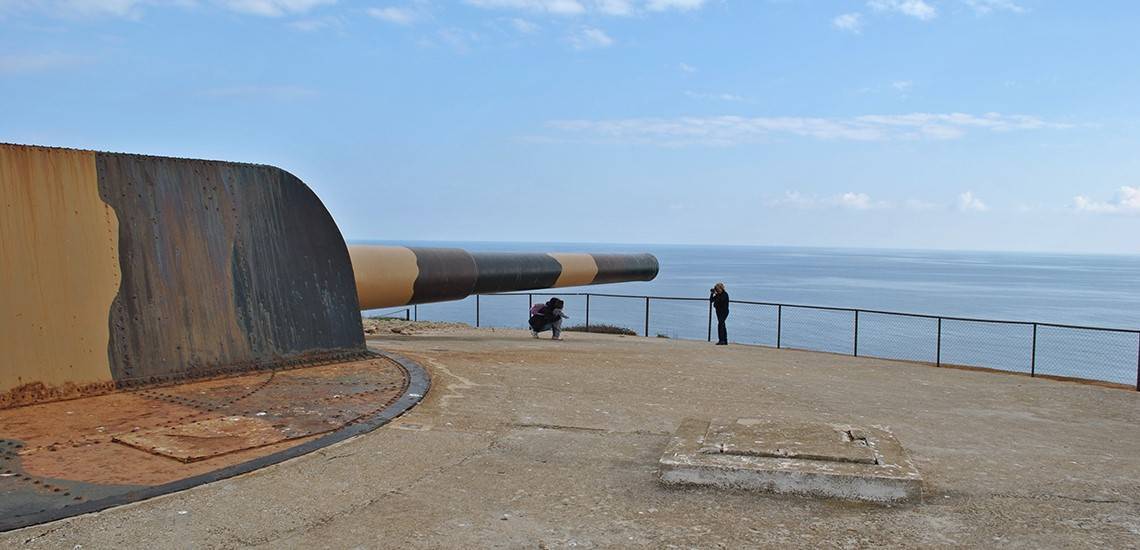 We are beginning to walk faster because we want to see the cannon, a Vickers of 381 mm. We have been told that it is one of the largest calibers to have been built in Spain. How great! A child asks his parents to get him into the tube. It's 18 meters his father says. In the end he gets to go in. From here you can see the Isla del Aire which is opposite Punta Prima, in Sant Lluís.
We are beginning to walk faster because we want to see the cannon, a Vickers of 381 mm. We have been told that it is one of the largest calibers to have been built in Spain. How great! A child asks his parents to get him into the tube. It's 18 meters his father says. In the end he gets to go in. From here you can see the Isla del Aire which is opposite Punta Prima, in Sant Lluís.
No one dared to attack La Mola
We have finished the tour and walk towards the exit. We are told that this fortress has never been attacked. Perhaps no one dared to approach it when seeing so many guns, although they say that they only fired twice here during the beginning of the Spanish civil war, in 1937.
We go back through the Queen's Gate. Between its walls was a metal box in which the constructors had kept gold and silver coins when they began working. How many stories have been told! Today we made a great trip back in time and I liked it a lot.
Now I am going back to Club Kikoland because they are waiting for me to come and eat. Did you like the adventures we have lived today in La Mola? the underground galleries, the deep trenches, and the canyons?
